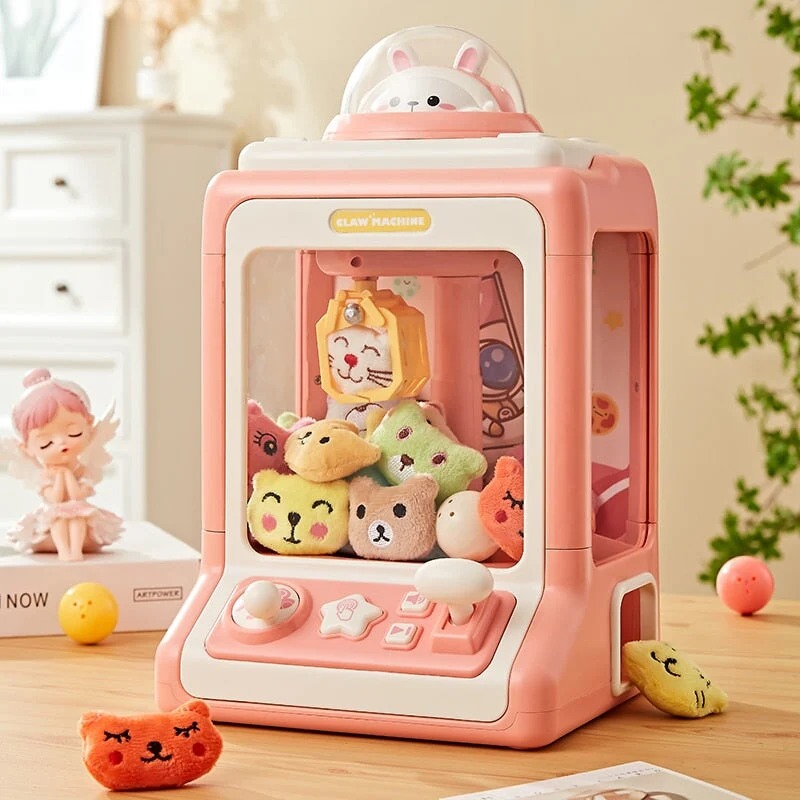Toy claw machines toys, often seen in arcades, shopping malls, and entertainment centers, have captivated both children and adults for decades. These machines, filled with an assortment of plush toys, gadgets, and trinkets, offer a tantalizing mix of challenge and reward. The thrill of maneuvering a mechanical claw to pick up a prize, coupled with the allure of the treasures within, makes toy claw machines a timeless attraction. This article delves into the history, mechanics, psychology, and modern trends surrounding toy claw machine toys, exploring why they continue to hold a special place in our hearts.
The Origins and Evolution of Toy Claw Machines
The concept of claw machines dates back to the early 20th century. Originally, these machines were inspired by the cranes used in construction and heavy lifting. The first versions, known as “crane diggers,” appeared in the 1920s and 1930s. These machines were simple in design, typically operated by a crank handle, and were often found at fairs and carnivals. Players would manipulate the crane to scoop up small prizes buried in sand or sawdust.
As technology advanced, so did the complexity and appeal of claw machines. By the 1950s and 1960s, electric claw machines became more widespread, featuring motorized controls and more sophisticated mechanisms. These machines began to appear in amusement parks and arcades, drawing crowds with their flashing lights and enticing prizes.
The modern claw machine, as we know it today, emerged in the late 20th century. These machines are typically encased in glass, filled with plush toys, and operated by a joystick and buttons. The prizes are now often placed on a flat surface or suspended in mid-air, making the game both visually appealing and challenging.
How Toy Claw Machines Work: The Mechanics Behind the Magic
Understanding the mechanics of toy claw machines can shed light on why they are both challenging and addictive. At its core, a claw machine consists of several key components:
- Control System: Modern claw machines are equipped with a joystick and buttons that allow players to maneuver the claw horizontally and vertically. Some machines also feature a time limit, adding to the challenge.
- Claw Mechanism: The claw itself is a mechanical arm with three or four prongs. When the player presses the button, the claw descends, attempts to grab a prize, and then ascends to drop the prize into the collection chute if successful.
- Prize Box: The transparent prize box is filled with various toys and trinkets. The arrangement and type of prizes can vary, with some machines offering high-value items to attract players.
- Payout Rate: Claw machines often have an adjustable payout rate, which determines how frequently the claw will successfully grab a prize. This rate is set by the operator and can make the game easier or harder.
- Electronics and Software: Modern claw machines are controlled by sophisticated electronics and software that manage the movement of the claw, the timing, and the payout rate. These systems ensure the machine operates smoothly and maintains player interest.
The Psychology of Toy Claw Machines: Why Are They So Addictive?
Toy claw machines tap into several psychological principles that make them highly engaging and often addictive. Here are a few reasons why these machines captivate our attention:
- Intermittent Rewards: Claw machines operate on a variable ratio reinforcement schedule, where rewards are given out unpredictably. This type of reward system is known to be highly addictive, as players are motivated to keep trying, hoping that the next attempt will be successful.
- Skill and Chance: Claw machines combine elements of skill and chance. While players need to control the claw accurately, the outcome is not entirely predictable, which creates a sense of challenge and excitement.
- Immediate Gratification: The possibility of winning a prize immediately after playing adds to the allure. The instant feedback and potential reward create a powerful incentive to keep playing.
- Visual and Auditory Stimuli: The bright lights, colorful prizes, and catchy music of claw machines are designed to attract attention and create a stimulating environment. These sensory stimuli enhance the overall experience and draw players in.
- Social Influence: Watching others play and win can be motivating. Seeing someone else successfully grab a prize can create a sense of competition and inspire others to try their luck.
Modern Trends in Toy Claw Machines
The world of toy claw machines has evolved significantly over the years, incorporating new technologies and trends to keep players engaged. Here are some modern trends that are shaping the future of claw machines:
Digital and Online Claw Machines
With the advent of the internet and mobile technology, digital claw machines have emerged, allowing players to control real claw machines remotely via their smartphones or computers. These online claw machines are often live-streamed, providing a virtual arcade experience from the comfort of home. Players can watch their attempts in real-time and have prizes shipped to them if they win.
Augmented Reality (AR) and Virtual Reality (VR) Integration
Some claw machine manufacturers are experimenting with AR and VR to enhance the gaming experience. By integrating these technologies, players can enjoy immersive gameplay with virtual claw machines or enhanced visual effects, making the experience even more engaging and interactive.
Customizable and Themed Machines
Claw machines are increasingly being customized to fit specific themes or events. For example, machines may feature seasonal decorations for holidays like Christmas or Halloween, or they might be themed around popular movies, TV shows, or video games. This customization helps to keep the machines relevant and exciting for players.
Eco-Friendly and Sustainable Prizes
In response to growing environmental concerns, some operators are opting for eco-friendly and sustainable prizes. These might include toys made from recycled materials, reusable items, or even digital rewards. This trend aligns with the increasing consumer demand for environmentally responsible products.
Skill-Based Claw Machines
To appeal to a broader audience, some claw machines are shifting towards a more skill-based model. These machines reward precise control and dexterity, giving skilled players a better chance of winning. This shift helps to balance the elements of skill and chance, making the game fairer and more appealing to experienced players.
The Cultural Impact of Toy Claw Machines
Toy claw machines have left an indelible mark on popular culture. They often appear in movies, TV shows, and video games, symbolizing both the joy of winning and the frustration of near misses. For many, these machines evoke nostalgic memories of childhood trips to the arcade or the excitement of winning a coveted prize.
Moreover, claw machines have become a social phenomenon in some regions. In Japan, for instance, “UFO catchers” (as they are known) are immensely popular and are a staple in arcades across the country. They have even inspired dedicated claw machine arcades, where players can find a vast array of machines and prizes.
Tips and Strategies for Winning at Toy Claw Machines
While claw machines are designed to be challenging, there are strategies that can increase your chances of success. Here are some tips for aspiring claw machine champions:
- Choose Your Machine Wisely: Not all claw machines are created equal. Look for machines that have a reasonable payout rate and are not overly crowded with prizes. A machine with fewer prizes may have a higher chance of success.
- Observe Before Playing: Spend some time watching the machine before you play. See if other players are winning and how the claw behaves. This can give you insights into the machine’s payout rate and the strength of the claw.
- Aim for Prizes Near the Drop Zone: Prizes that are closer to the drop chute are easier to win. Avoid prizes that are tightly packed or buried under other items.
- Position the Claw Precisely: Take your time to align the claw accurately above your chosen prize. Use the joystick to position the claw and ensure it is centered before you press the button to lower it.
- Go for the Grab: Aim to grab the prize firmly around the middle. Claws are designed to pick up objects that have a clear center of gravity, so try to position the claw to grab the most stable part of the prize.
- Practice Makes Perfect: Like any game, practice improves your skills. The more you play, the better you’ll become at judging distances and positioning the claw.
Conclusion
Toy claw machines are more than just arcade games; they are a blend of nostalgia, excitement, and challenge. Their enduring appeal lies in the combination of skill and chance, the allure of the prizes, and the sensory experience they provide. From their humble beginnings as simple crane diggers to the sophisticated digital and themed machines of today, claw machines have evolved to capture the imagination of generations.
As technology continues to advance, the future of toy claw machines looks promising, with new innovations set to enhance the gaming experience further. Whether you’re a seasoned pro or a curious beginner, the thrill of the claw machine awaits, offering endless fun and the tantalizing possibility of winning that perfect prize.






